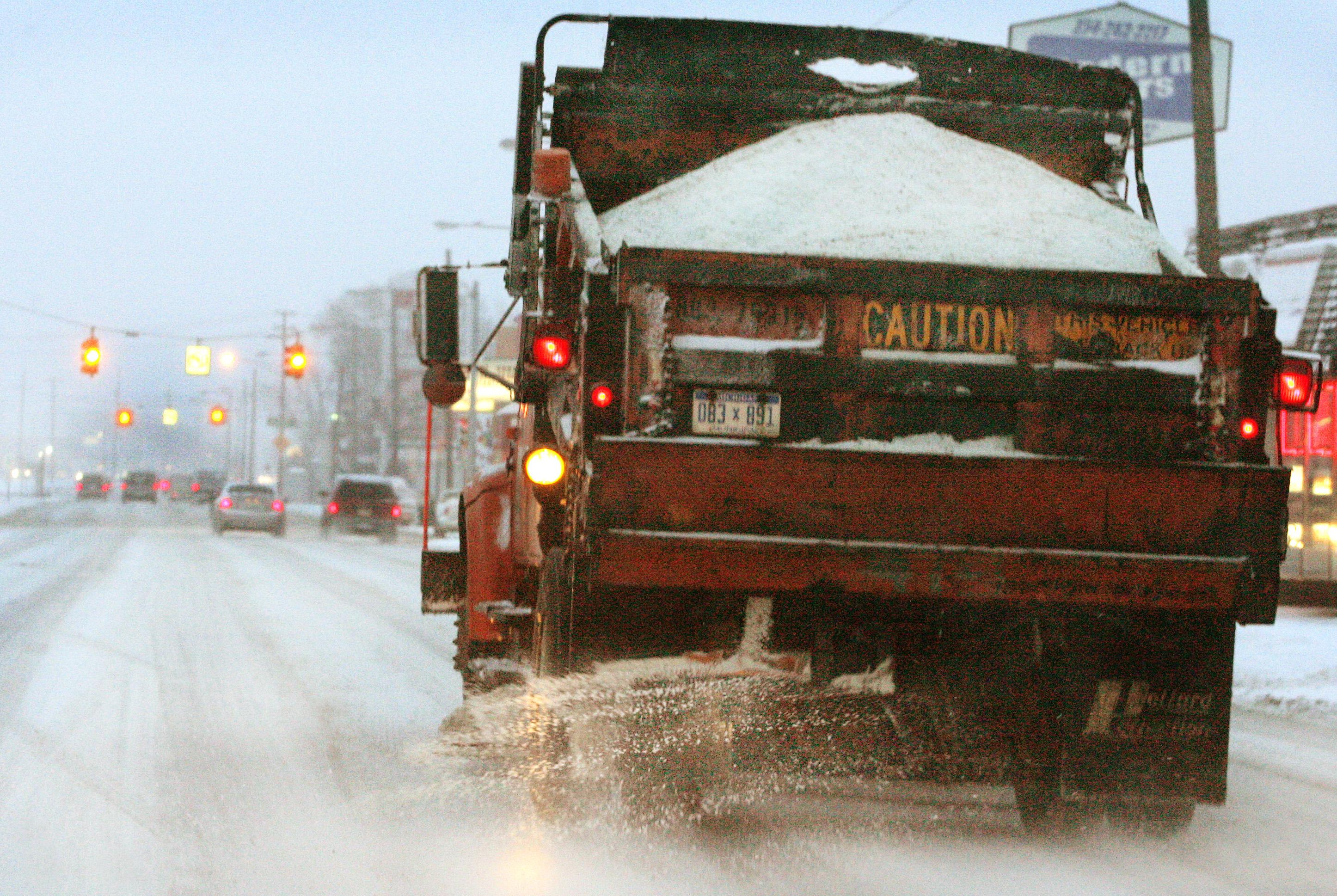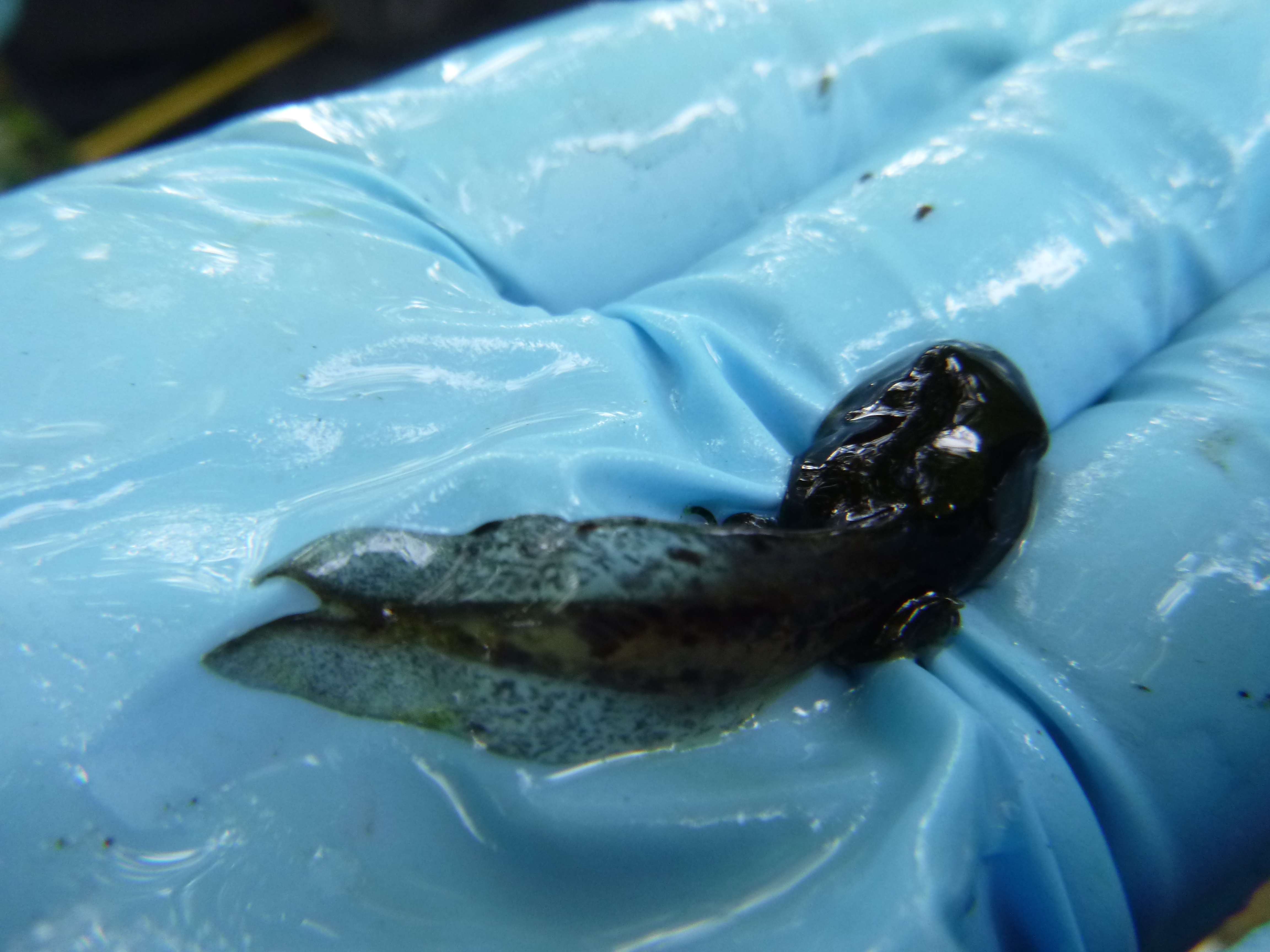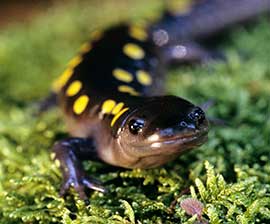Carly Eakin – PhD Researcher, University of Maine; Department of Wildlife, Fisheries, and Conservation Biology
We’ve all seen the carnage of frogs hit on roads during warm, rainy spring nights, but roads have other, not so obvious impacts on amphibians, especially in areas with cold climates.
Cold climates mean ice and snow on roads, and most wintery areas in North America rely on road salt to improve safety for motorists. And we use a lot of salt. Salt is typically applied at far higher rates than are needed to maintain safe roadways, as a sort of insurance policy to error on the side of safety for motorists. Also, much salt is still applied in rock form (which bounces off of roads) as opposed to more cost-effective salt slurries which are sprayed onto roads. Unfortunately, road salts contaminate pools and other water supplies near roads. Salt spray from traffic driving on wet, salty roads can be carried by wind even 100’s of feet away, and during spring snowmelt, salts are carried in runoff to pools near roadways where tiny tadpoles are developing.
Extra salty water may mean trouble for the frogs and salamanders developing in these pools. Wood frog tadpoles exposed to road salt contaminated water have lower weights, more physical abnormalities, and higher mortality rates than tadpoles living in water with natural salt concentrations associated with forested pools far from roads. Spotted salamander larvae also have higher mortality rates when raised in road salt contaminated water in laboratory experiments and natural pools. These effects may reduce the number of frogs and salamanders that survive to become part of the breeding population.
Salt application can also impact human drinking water supplies. For example, studies have documented contaminated and, in some cases, toxic salinity levels in streams and groundwater supplies which provide drinking water to private wells in many places, including New Hampshire, New York, Minnesota, and Ontario.
As people who care about our environment and wildlife but also value safe winter roadways, what can we do? Although as of yet no perfect solution exists, there are several ways to reduce our effect on water and aquatic life without sacrificing our safety. Many strategies that can reduce our salt use and environmental impact happen at the town or state level. To help wildlife and humans, you can support initiatives to reduce use of road salts.
7 ways to reduce road salt use
- Improve safety with snow-tires, not more salt – An extensive comparative study by the University of Alaska Fairbanks and the Alaska Department of Transportation found that lightweight studded snow tires decreased stopping distance on icy surfaces by approximately 30 feet. This seems like a good reason to change your tires with the season!
- Use alternative snowmelt treatments – Sand and dirt can also be used to provide traction for vehicles. These materials can also contribute to sedimentation in wetlands and streams receiving road runoff, but environmental remediation of sedimentation is easier than that for salinity.
- Apply salt slurry instead of rock salt – Much of the rock salt applied to roads bounces off to the median. This means that a much greater amount of salt is applied than is actually used to melt snow and ice on the road. When salt slurry is applied, much less salt is needed because almost all the salt makes contact with the road surface. This not only is better for the environment, but ultimately costs less!
- Designate “low salt” and “low speed” areas – Select areas with low traffic volumes and where it is reasonable to reduce the speed limit during wintery conditions.
- Use anti-ice technologies – Consider use of road construction materials, like verglimit, that prevent ice from adhering to the roadway or have ice-melting properties.
- Plant buffers of salt-tolerant vegetation next to roads – Vegetation can help stop the distance from the road that wind carries salt spray.
- Place new roads far from wetlands or away from sensitive habitat.
References
Daley ML, Potter JD, and McDowell WH. 2009. Salinization of urbanizing New Hampshire streams and groundwater: effects of road salt and hydrologic variability. Journal of the North American Benthological Society 28.4: 929-940.
Engineering Research and Development Bureau, Research Report 132. 1986. 23. http://www.michigan.gov/documents/ch2-deice_51438_7.pdf. Accessed 25 Nov 2015.
Karraker NE and Ruthig GR. 2009. Effect of road deicing salt on the susceptibility of amphibian embryos to infection by water molds. Environmental research 109:40–5.
Karraker NE, Gibbs JP, and Vonesh JR. 2008. Impacts of road deicing salt on the demography of vernal pool-breeding amphibians. Ecological Applications 18.3:724-734.
Kelly VR, Lovett GM, Weathers KC, Findlay SEG, Strayer DL, Burns DJ, and Likens GE. 2008. Long-term sodium chloride retention in a rural watershed: legacy effects of road salt on streamwater concentration. Environmental science & technology 42.2:410-415.
Lu J. 1996. Vehicle Traction Performance on Snowy and Icy Surfaces. Transportation research record. 1536:82-89.
Novotny EV, Sandler AR, Mohseni O, and Stefan HG. 2009. Chloride ion transport and mass balance in a metropolitan area using road salt. Water resources research 45.12.
Sanzo D and Hecnar SJ. 2006. Effects of road de-icing salt (NaCl) on larval wood frogs (Rana sylvatica). Environmental pollution 140:247–56.
Turtle SL, Journal S, and Mar N. 2000. Embryonic Survivorship of the Spotted Salamander (Ambystoma maculatum ) in Roadside and Woodland Vernal Pools in Southeastern New Hampshire. 34:60–67.
Williams DD, Williams NE, and Cao Y. 2000. Road salt contamination of groundwater in a major metropolitan area and development of a biological index to monitor its impact. Water Research 34.1:127-138.



